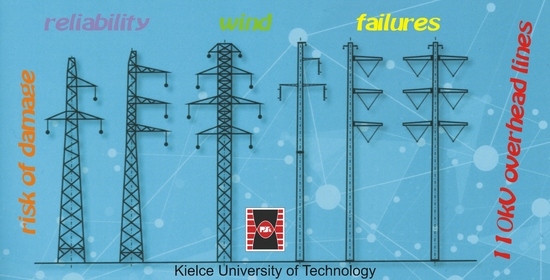Assessment of the Risk of Damage to 110 kV Overhead Lines Due to Wind
Abstract
:1. Introduction
2. Materials and Methods
2.1. Impact of Wind on the Operation of Power Equipment
2.2. Data and Sources
2.3. Model Approach-Unreliability Testing of a Structure under Conditions of Its Variable Strength and under Exposures of Variable Values
- Relatively low dispersion of load values:
- 2.
- Relatively low dispersion of strength values:
- 3.
- Approximate dispersion of load and strength values:
- –
- structure’s load of Lli:
- –
- structure’s strength greater than or equal to Sli = Lli:
3. Results and Discussion
3.1. Analysis of the Impact of Wind Speed on the Failure Rate of 110 kV Overhead Power Lines—A Case Study
3.2. Analysis and Interpretation of Results
4. Conclusions
Funding
Institutional Review Board Statement
Informed Consent Statement
Data Availability Statement
Conflicts of Interest
References
- Allan, R.N.; Billinton, R. Reliability Evaluation of Power Systems, 2nd ed.; Springer: Boston, MA, USA, 2013; ISBN 978-1-4899-1860-4. [Google Scholar]
- Brown, R.E. Electric Power Distribution Reliability; CRC Press, Taylor & Francis Group: Boca Raton, FL, USA, 2009. [Google Scholar]
- Ui-Min, C.; June-Seok, L. Comparative Evaluation of Lifetime of Three-Level Inverters in Grid-Connected Photovoltaic Systems. Energies 2020, 13, 1227. [Google Scholar]
- Chojnacki, A.Ł.; Chojnacka, K.J. Niezawodność Elektroenergetycznych Sieci Dystrybucyjnych; Publishing House of the Świętokrzyska University of Technology: Kielce, Poland, 2018; ISBN 978-83-65719-28-7. [Google Scholar]
- Johnson, M.; Gorospe, G.; Landry, J.; Schuster, A. Review of mitigation technologies for terrestrial power grids against space weather effects. Int. J. Electr. Power Energy Syst. 2016, 82, 382–391. [Google Scholar] [CrossRef]
- Narimani, A.; Nourbakhsh, G.; Ledwich, G.F.; Walker, G.R. Optimum electricity purchase scheduling for aggregator storage in a reliability framework for rural distribution networksInt. J. Electr. Power Energy Syst. 2018, 94, 363–373. [Google Scholar] [CrossRef]
- Sousa, B.J.O.; Humayun, M.; Pihkala, A.; Lehtonen, M.I. Three-layer seasonal reliability analysis in meshed overhead and underground subtransmission networks in the presence of co-generation. J. Electr. Power Energy Syst. 2014, 63, 555–564. [Google Scholar] [CrossRef]
- Department of Defense USA. Military Standardization Handbook. Reliability Prediction of Electronic Equipment; MIL-HDBK 217B; U.S. Government Printing Office: Washington, DC, USA, 1974. [Google Scholar]
- Campbell, R.J. Weather-Related Power Outages and Electric System Resiliency; Congressional Research Service: Washington, DC, USA, 2012. [Google Scholar]
- Panteli, M.; Pickering, C.; Wilkinson, S.; Dawson, R.; Mancarella, P. Power System Resilience to Extreme Weather: Fragility Modeling, Probabilistic Impact Assessment, and Adaptation Measures. IEEE Trans. Power Syst. 2017, 32, 3747–3757. [Google Scholar] [CrossRef] [Green Version]
- Arvids, J.; Aigars, L. Weather impacts on the household electric energy consumption. Res. Rural Dev. 2016, 1, 248–253. [Google Scholar]
- Bolzern, P.; Fronza, G. Role of weather inputs in short-term forecasting of electric load. Int. J. Electr. Power Energy Syst. 1986, 8, 42–46. [Google Scholar] [CrossRef]
- Collins, S.; Deane, P.; Gallachoir, B.; Pfenninger, S.; Staffell, I. Impacts of Inter-annual Wind and Solar Variations on the European Power System. Joule 2018, 2, 2076–2090. [Google Scholar] [CrossRef] [PubMed] [Green Version]
- Paliwal, N.K.; Singh, A.K.; Singh, N.K. Short-term Optimal Energy Management in Stand-alone Microgrid With Battery Energy Storage. Arch. Electr. Eng. 2018, 67, 499–513. [Google Scholar]
- Sangrody, H.; Sarailoo, M.; Zhou, N.; Tran, N.; Motalleb, M.; Foruzan, E. Weather forecasting error in solar energy forecasting. IET Renew. Power Gener. 2017, 11, 1274–1280. [Google Scholar] [CrossRef] [Green Version]
- Chojnacki, A.Ł.; Kaźmierczyk, A. Influence of ambient temperature on the intensity of failures of MV/LV power distribution substations. Logistic 2014, 6, 2610–2618. [Google Scholar]
- Migdalski, J. Inżynieria Niezawodności—Poradnik; ATR Bydgoszcz: Warsaw, Poland, 1992. [Google Scholar]
- PN-EN 1991-1-4:2008 Oddziaływanie na Konstrukcję—Część 1-4: Oddziaływanie Ogólne—Oddziaływanie Wiatru, Polish version of EN 1991-1-4:2005 Actions on structures—Part 1-4: General actions—Wind actions; Polish Committee for Standardization: Warsaw, Polish, 2005.
- PN-EN 50341-2-22:2016 Elektroenergetyczne Linie Napowietrzne Prądu Przemiennego Powyżej 1 kV—Część 2-22: Krajowe Warunki Normatywne (NNA) dla Polski; Warsaw—Based on EN 50341-1:2012 Overhead electrical lines exceeding AC 1 kV—Part 2-22: Normative National Aspects; Polish Committee for Standardization: Warsaw, Polish, 2016.
- PN-EN 50341-1:2013 Elektroenergetyczne Linie Napowietrzne Prądu Przemiennego Powyżej 1kV—Część 1: Wymagania Ogólne—Specyfikacje Wspólne, Polish version of EN 50341-1:2012 Overhead electrical lines exceeding AC 1 kV—Part 1: General requirements—Common specifications; Polish Committee for Standardization: Warsaw, Polish, 2014.
- PN-EN 60652:2006: Badania Obciążeniowe Konstrukcji Wsporczych Elektroenergetycznych Linii Napowietrznych, Polish version of EN 60652:2004 Loading tests on overhead line structures; Polish Committee for Standardization: Warsaw, Polish, 2006.
- Ahmed, T.; Muttaqi, K.M.; Agalgaonkar, A.P. Climate change impacts on electricity demand in the State of New South Wales, Australia. Appl. Energy 2012, 98, 376–383. [Google Scholar] [CrossRef]
- PN-75/E 05100 Elektroenergetyczne Linie Napowietrzne. Projektowanie i Budowa; Polish Committee for Standardization: Warsaw, Polish, 1975.
- PN-E 05100-1:1998 Elektroenergetyczne Linie Napowietrzne. Projektowanie i budowa. Linie Prądu Przemiennego z Przewodami Roboczymi Gołymi; Polish Committee for Standardization: Warsaw, Polish, 1998.
- Chojnacki, A.Ł.; Kaźmierczyk, A.; Stobiecki, A. Właściwości niezawodnościowe napowietrznych linii dystrybucyjnych 110 kV. Wiadomości Elektrotechniczne 2017, 7, 15–19. [Google Scholar] [CrossRef]






| <10 Lat | 10–25 Lat | 25–40 Lat | >40 Lat |
|---|---|---|---|
| 11% | 17% | 30% | 42% |
Publisher’s Note: MDPI stays neutral with regard to jurisdictional claims in published maps and institutional affiliations. |
© 2021 by the author. Licensee MDPI, Basel, Switzerland. This article is an open access article distributed under the terms and conditions of the Creative Commons Attribution (CC BY) license (http://creativecommons.org/licenses/by/4.0/).
Share and Cite
Chojnacki, A.L. Assessment of the Risk of Damage to 110 kV Overhead Lines Due to Wind. Energies 2021, 14, 556. https://doi.org/10.3390/en14030556
Chojnacki AL. Assessment of the Risk of Damage to 110 kV Overhead Lines Due to Wind. Energies. 2021; 14(3):556. https://doi.org/10.3390/en14030556
Chicago/Turabian StyleChojnacki, Andrew Lukas. 2021. "Assessment of the Risk of Damage to 110 kV Overhead Lines Due to Wind" Energies 14, no. 3: 556. https://doi.org/10.3390/en14030556







